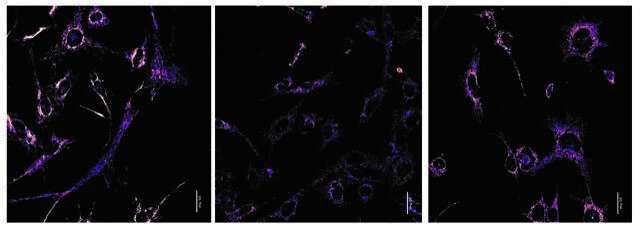Left: Control cells with only the C57 mtDNA variant. Center: Heteroplasmic cells, containing C57 and NZB mtDNA variants in the cytoplasm. Right: Heteroplasmic cells treated with an activator of P-ERK, which restores the normal distribution and quantity of mitochondria. Credit: CNIC
Research at the Centro Nacional de Investigadores Cardiovasculares (CNIC) has identified the mechanism of competition between distinct mitochondrial genomes coexisting in the same cell. The study, published today in Science Advances, examines why the simultaneous presence of more than one variant of mitochondrial DNA (mtDNA) in a cell is rejected in most cells, which select a single mtDNA variant whose identity depends on the tissue.
The study was coordinated by Dr. José Antonio Enríquez, head of the Functional Genetics of the Oxidative Phosphorylation System laboratory at the CNIC. Mitochondrial DNA is genetic material passed exclusively from mother to offspring. The research team found that the selection between mtDNAs present in the same cell depends on their impact on cell metabolism and can be influenced by differences in gene function, the action of drugs, or dietary changes. These factors together determine the preference for a particular mtDNA variant.
The study is the result of more than five years of research and collaborations with several laboratories across Europe. The results show that cells can detect the presence of mitochondria with distinct mtDNA genomes and select the variant more suited to the metabolic needs of the specific cell type. This explains how the selected mtDNA variant can differ between cell types.
"The study establishes that the selection of a mtDNA variant depends on the cell type and not the tissue, as was thought previously," explained Dr. Ana Victoria Lechuga-Vieco, first author on the study. "The preference of a cell for a specific mitochondrial variant depends on the cell's metabolic program and on several nuclear genes that have subtle effects on metabolism and the control of mitochondrial quality. We have shown that this mechanism is a process of functional selection."
Mitochondria are organelles present in the cytoplasm of most eukaryotic cells. Mitochondria provide most of the available energy in the cell by generating ATP (adenosine triphosphate)—the main source of energy in living organisms—in the respiratory chain. Mitochondria have their own DNA, which accounts for just 0.2% of the genetic information in humans and encodes 37 genes.
"The coexistence of more than one mtDNA variant in the same cell is more common than expected in humans and can be the result of new treatments for mitochondrial diseases and new medical technologies involving mitochondrial donation. This situation is defined technically as heteroplasmy. Understanding the implications of heteroplasmy is of vital importance for evaluating the safety of the procedures that cause it," explained Dr. Enríquez.
Dr. Ana Latorre-Pellicer, coauthor on the article and currently an investigator at the University of Zaragoza, says that the new study "provides the first description of the presence of more than once mitochondrial genome at the cellular level, as well as defining the mechanism of competition between distinct mitochondrial genomes within the same cell."
The research was conducted using mice with distinct mitochondrial genomes coexisting in individual cells. This model system allowed the team to determine how cells select one mitochondrial variant to avoid the presence of more than one type of mtDNA and to study the complexity of the communication between cell nuclei and mitochondria.
Moreover, the researchers add, the study has identified molecular targets for the development of tools to control mtDNA selection and cell metabolism in order to prevent the accidental generation of heteroplasmy through new medical procedures. These new technologies include the transplantation of healthy mitochondria to prevent mitochondrial diseases, injection of mitochondria into oocytes to increase fertility, and the proposed transfer of mitochondria in cell therapies to treat diverse diseases, including cardiovascular, lung, and neurological diseases.
More information: "Cell identity and nucleo-mitochondrial genetic context modulate OXPHOS performance and determine somatic heteroplasmy dynamics" Science Advances (2020). advances.sciencemag.org/lookup … .1126/sciadv.aba5345
Journal information: Science Advances
Provided by Centro Nacional de Investigaciones Cardiovasculares Carlos III (F.S.P.)























